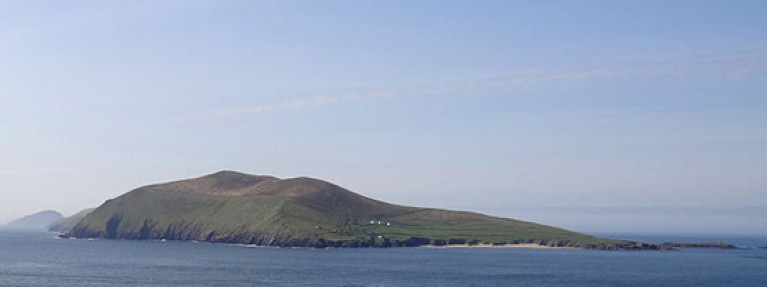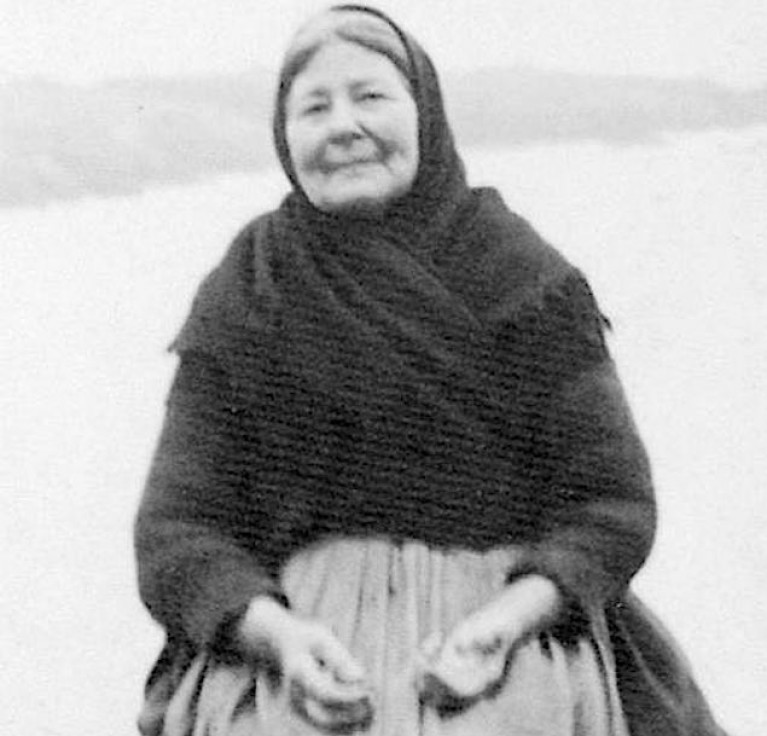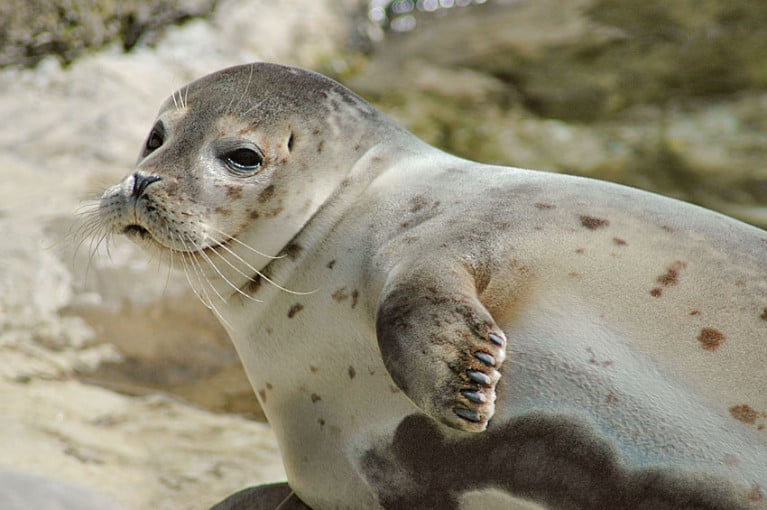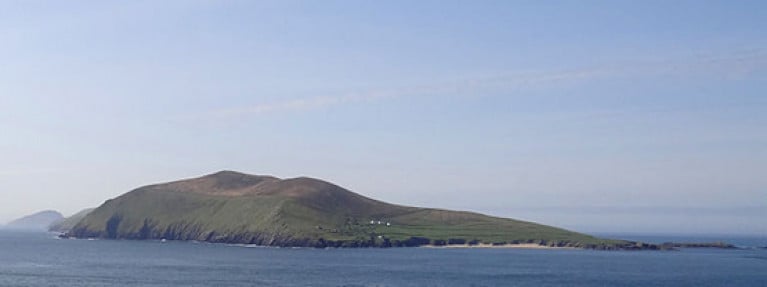Displaying items by tag: Blasket Islands
How a Mirror on a Paddle Saved The Lives of Divers and an Artist off the Kerry Coast
Imagine being on your own on a Blasket island, dependent on several divers to come and collect you – and then their dinghy runs out of fuel.
If a fishing vessel hadn’t spotted the reflection of a mirror they had tied to the top of an oar, the divers and artist Maria Simonds-Gooding might not be here to tell the tale.
Not only that, but a particular encounter after they were all brought ashore would change her life.
 Etching of Inis Mhic Oileáin by Maria Simonds-Gooding
Etching of Inis Mhic Oileáin by Maria Simonds-Gooding
In her latest interview for Wavelengths, Simonds-Gooding recounts her experiences of living on the edge of the Kerry coast.
She also has some interesting observations on how Blasket islanders adjusted when they moved to the mainland after the government evacuated them in November 1953.
She first recalled that first visit to Inis Mhic Oileáin, where she had no means of communication as she waited for that lift back to the mainland.
Listen to Wavelengths below
'The Great Blasket Island is Like Stepping into a Different Time and Place' - Taoiseach Leo Varadkar
Taoiseach Leo Varadkar and Patrick O’Donovan, Minister of State for the Office of Public Works, paid a visit to County Kerry on Saturday to witness the restoration of An Blascaod Mór (the Great Blasket) by the OPW. They also graced the annual ‘Ceiliúradh an Bhlascaoid’ commemoration with their presence.
During his visit, Taoiseach Varadkar expressed his admiration for the Great Blasket, calling it one of the most beautiful places in Ireland and a priceless cultural asset. He emphasised the importance of preserving the island and its villages as a legacy and a unique tourism asset, adding that the OPW is doing an essential task of conserving and protecting the Great Blasket to benefit visitors from Ireland and overseas.
“The Great Blasket is like stepping into a different time and place. It’s living history and heritage. It’s essential that we preserve the island and its villages, as an irreplaceable legacy, and a unique tourism asset,” the Taoiseach said.
 Lorcan Ó Cinneide manager of the Blasket Centre and Great Blasket Island was on hand to take the Taoiseach Leo Varadkar and Patrick O’Donovan around the Great Blasket Island including the former home on the Great Blasket of author Tomás Ó Criomhthain, which has been restored by the Office of Public Works Photo: Domnick Walsh
Lorcan Ó Cinneide manager of the Blasket Centre and Great Blasket Island was on hand to take the Taoiseach Leo Varadkar and Patrick O’Donovan around the Great Blasket Island including the former home on the Great Blasket of author Tomás Ó Criomhthain, which has been restored by the Office of Public Works Photo: Domnick Walsh
He further stated that the current focus is on improving the landing facilities on the island and the island itself in a way that protects nature and wildlife.
In addition to inspecting the restoration work, the two dignitaries attended the Annual ‘Ceiliúradh an Bhlascaoid’ at the fully restored Ionad an Bhlascaoid/The Blasket Centre, which has been the venue for this three-day event on the history and heritage of the Blasket Islands since 1996.
The theme of this year's gathering was "Turas go Tír na nÓg – Óige an Bhlascaoid Mhóir agus Sliocht an Oileáin i gCéin" (A Trip to the Land of Youth: Youth on the Great Blasket and Island families abroad), with a focus on youth on the island.
This year’s caretakers of Great Blasket Island have spoken of their “beautiful time” on the island looking after its holiday cottages over the summer months.
But they also shared their disappointment at the behaviour or some of the hundreds of visitors to the popular destination off the Co Kerry coast.
Speaking to Newstalk’s Pat Kenny Show, Claire de Haas spoke of one incident where someone picked up and mistreated a newborn seal pup for a selfie — inadvertently causing its death as it was rejected by its mother.
“There is no signage on the island to educate or inform people about general wildlife rules or the seals,” de Haas said.
Another issue is the absence of public toilets on the island, especially since the closure of its single small café.
Reacting to reports of some visitors relieving themselves in the ruins of famed storyteller Peig Sayers’ historic home on the island, Minister of State Patrick O’Donovan told RTÉ News that people should “exercise cop-on”.
“We personally think it’s ridiculous,” said de Haas on the toilet situation. “I think people should be informed before they go on the boat and boat companies inform the guests before they get on.”
Newstalk has more on the story HERE.
Blasket islanders may be remembered as writers, but they were also artists. A new book curated by artist Maria Simonds-Gooding which is due to be published next month, highlights the creative spirit of the late Blasket islander Mícheál Ó Gaoithín.
Life on the Great Blasket depicts gulls and puffins, lobsters, seals, men towing a cow behind a currach, goats in a churchyard, and his mother Peig Sayers are among images which Ó Gaoithín painted and which are reproduced in the book.
As The Sunday Times reports, Simonds-Gooding first met Ó Gaoithín 54 years ago when he was living on the Kerry mainland and was known locally as “An File” for his poetry, storytelling and translation work.
Simonds-Gooding introduced him to painting after she left paper, paints and brushes on his kitchen table.
 An Blascaod Mór an tan a bhí sé i réim | The Great Blasket in its prime | coloured pencils, blue biro and graphite | 25.4 cm x 34.8 cm. Artwork by Mícheál Ó Gaoithín. Copyright Maria Simonds-Gooding
An Blascaod Mór an tan a bhí sé i réim | The Great Blasket in its prime | coloured pencils, blue biro and graphite | 25.4 cm x 34.8 cm. Artwork by Mícheál Ó Gaoithín. Copyright Maria Simonds-Gooding
Though he didn’t seem to take much heed of her gesture, he next greeted her with a celebration of his mother, “painted freely with luminous brushstrokes in bold yellow watercolour”.
He had captured Sayers sitting by the fire with a magnificent grey cat, its tail wrapped around a red footstool, staring out from the foreground.
“Though the painting is sparse, it is all the more rich and colourful in what it includes, “she writes in her introduction to a selection of his naive art, which is due to be published next month (November 2022) by Lilliput Press.
“Here was this lonely man, dreaming night and day of the life he had lived on the Blasket Islands, and now he was reliving those memories through a whole new visual medium with which he had never worked before,” she continues.
“It must have been a great discovery for him. We put a few more sods of turf on the fire to mark the start of an enduring and close friendship..”
 Book cover for An File (The Poet), Mícheál Ó Gaoithín, The Blasket Painter edited by Maria Simonds-Gooding. Sochraid ar an Oileán | An Island funeral | watercolour | 20.2 cm x 27.5 cm. Artwork by Mícheál Ó Gaoithín. Copyright Maria Simonds-Gooding
Book cover for An File (The Poet), Mícheál Ó Gaoithín, The Blasket Painter edited by Maria Simonds-Gooding. Sochraid ar an Oileán | An Island funeral | watercolour | 20.2 cm x 27.5 cm. Artwork by Mícheál Ó Gaoithín. Copyright Maria Simonds-Gooding
An File Micheál Ó Gaoithín: The Blasket Painter”: Selected and Introduced by Maria Simonds-Gooding is published by Lilliput Press on November 3rd, and copies can be pre-ordered here
Its publication coincides with a special exhibition of Peig Sayers at the Museum of Literature Ireland.
The book is also being launched on November 19th at the Blasket Centre in Kerry as part of the Dingle Literary Festival, and there is a panel discussion with Maria Simonds-Gooding, Cristín Leach and Seamus Barra Ó Suilleabháin.
More details here
Read more in The Sunday Times here
RTÉ News reports that 10 people were rescued from a boat taking on water off the Blasket Islands yesterday evening, Friday 8 July.
Nine of the group took refuge on a local fishing boat that diverted to assist while one remained on board in an attempt to save the casualty vessel, which was towed to Dingle by another local vessel.
RTÉ News has more on the story HERE.
Blasket Islands Ferry Company Up For Sale
One of the ferry companies that services the Blasket Islands is up for sale, as RTÉ Nuacht reports.
Bádóirí an Bhlascaoid Teo operates a 48-passenger ferry between the island of Great Blasket and Dunquin in Co Kerry and is the longest established company running to the islands.
Great Blasket Island has been uninhabited for nearly 70 years but for caretakers to manage the busy tourism season — which was bolstered last year by Irish people holidaying at home during a brief relaxation of pandemic restrictions.
RTÉ Nuacht has more on the story HERE.
Seirbhís farantóireachta chun an Bhlascaoid Mhóir ar díol: Tá ceann de na comhlachtaí farantóireachta a fhreastalaíonn ar an Blascaod Mór ar díol. https://t.co/0A9uFQQGZ9 pic.twitter.com/jaSDgQfDWQ
— 7 LÁ (@7LATG4) April 7, 2021
Seal Cull Plan is a Non-Starter for Government Ministers
Today’s Sunday Independent reports that Government ministers have shot down proposals for a seal cull by rifle from boats off Cork and Kerry.
Internal emails show that Minister of State Malcolm Noonan rejected the suggestion as being “politically unacceptable”.
And both he and Housing Minister Darragh O’Brien shared the view that a compensation scheme for fishermen who say seal predation on fish stocks has harmed their livelihoods “would be a better approach”.
As previously reported on Afloat.ie, inshore fishermen in Kerry have argued that the depletion of fishery stocks and damage to nets in and around the Blasket Islands is “unsustainable”.
But suggestions that fishermen be given the green light to cull seals from their vessels with high-powered rifles were branded as “insane” by a conservation expert.
The Sunday Independent has more on the story HERE.
Blasket Islander Peig's More "Flirtatious" Side in New Collection
As if there wasn’t enough Kerry sadness with Fungie’s disappearance, along comes Peig Sayers...
As The Sunday Independent reports today, a newly published collection of stories by one of the Great Blasket’s best-known residents shows her “grámhar or more flirtatious side.
The new dual-language publication, entitled Níl Deireadh Ráite/Not the Final Word, is published by New Island Press.
It has been collated by Dr Pádraig Ó Héalaí of NUI Galway (NUIG)and the late Prof Bo Almqvist of University College Dublin (UCD) and includes recordings of Sayers on audio CDs.
A woman who liked a sup of whiskey and was a feminist of her time, Sayers is still synonymous with nightmares among past generations of secondary school students who studied her autobiography, Peig.
“The image of her created by the text on the Leaving Certificate curriculum was unfortunate, as it didn’t give a good indication of the woman she really was, “ Dr Ó Héalaí says.
A tale of a woman who had a child with a merman, and other stories which showed a more open, complex and often defiant character, are among the accounts gathered.
Ó Héalaí and Almqvist drew on remastered recordings by the Irish Folklore Commission, which were taped in 1952 when Sayers was being treated for cancer in St Anne’s Hospital in Ranelagh, Dublin.
The two men had published a previous collection, entitled Labharfad le Cách / I will Speak to you All, over a decade ago. This work referred to BBC, RTÉ and UCD archives of Sayers’s stories – now translated into many languages including Esperanto.
Sayers, who died in 1958, was born near Dún Chaoin and married a Blasket islander Pádraig Ó Guithín. The couple lost five of ten children – three in infancy, one of measles, and their teenage son Tomás died when he fell down a cliff.
Although she knew much poverty and hardship, she was well able to have a laugh, was “interested in lads”, had an emerging sexuality and a gift for language which included being able to utter a “good curse”, Ó Héalaí adds.
The stories are “not all entertainment” as one very touching account is of a farming couple whose three children all died young, and were helped in their grief by a story from a stranger, Ó Healái says.
Four of Sayers’s surviving five children emigrated to the US, and she related her autobiography – published in Irish in 1936 - to Maidhc, the only one who stayed at home.
Fellow folklorist and sean nós singer Lillis Ó Laoire of NUIG’s school of Irish says the new release deserves to be a “Christmas bestseller”.
Sayers’s warmth and humour and ability to be “sexy” are well reflected between its pages, he says – noting that one of the great “myths” is that her biography was compulsory for Leaving Certificate Irish.
“It never was – it was up to the individual teachers to select texts,” Ó Laoire says.
“There are about 5,000 pages of manuscript in the Irish Folklore Commission, so this is only touching on what is still there,” Dr Ó Healaí explains.
“Hence the title of the book!”
Níl Deireadh Ráite/Not the Final Word (New Island Press) is on sale for €25
Read The Sunday Independent here
Plans For Fishermen’s Seal Cull By Rifle Branded ‘Insane’
Plans to allow for the culling of seals by fishermen with high-powered rifles have been branded as “insane” by a conservation expert.
According to the Irish Examiner, the Government is looking into the granting of licences that would permit fishermen to shoot seals in order to protect their catches.
The move follows claims by local fishermen in Kerry that seal colonies in the Blasket Islands — a Special Area of Conservation — and elsewhere are largely responsible for depleted fish stocks and damage to nets, a situation which they say is “unsustainable”, as previously reported on Afloat.ie.
While a licence for the Blaskets was refused, one of four others this year has been approved, and the rest — across Kerry and Cork — are being considered by Local Government Minister Darragh O’Brien.
“There are concerns about this approach to seal management, given the potential safety concerns arising from using high-powered rifles on moving platforms,” the minister said in a written response to Kerry TD Micael Healy-Rae.
"Nonetheless, my department is examining the potential for a pilot scheme which would test this approach and determine its efficacy in protecting fishermen’s catches.”
However, Irish Wildlife Trust’s Pádraic Fogarty said the idea of “shooting seals with rifles from boats is insane”, and suggested that chronic overfishing and bottom trawling have had a greater impact on available catches.
His comments echoed those of the Irish Seal Sanctuary earlier this year. Its co-founder Brendan Price told RTÉ that culling seals by gun is “essentially wasting a bullet, it’s futile”.
The Irish Examiner has much more on the story HERE.
‘Cull Not The Answer’ Says Seal Sanctuary As Fishermen Renew Call
The Irish Seal Sanctuary has said a seal cull is not the answer to the woes of Dingle Peninsula fishermen, who claim a booming population of the protected marine wildlife is putting their livelihood at risk.
Sanctuary co-founder Brendan Price told RTÉ News that “you’re essentially wasting a bullet, it’s futile” as “an apex predator such as a seal is controlled by the available food source”.
Late last year, inshore fishermen who work around the Blaskets, which is a Special Area of Conservation, blamed the local seal colonies for depleted fish stocks and damage to their nets, arguing the situation was “unsustainable”.
Now the fishermen say they are “at breaking point”, with one claiming that seals actively follow their boats to target their catch.
RTÉ News has more on the story HERE.

































































